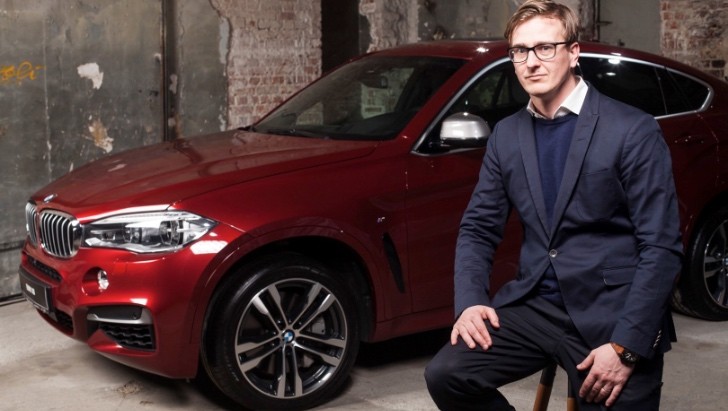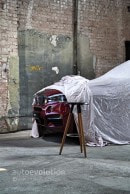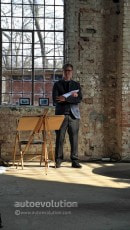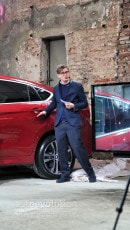To anyone who's ever laid his eyes on a BMW X6, the new model looks like more than just a step up. To be honest, we never enjoyed the company of the original E71 X6, but the 250,000 people who bought it determined the automaker to invest heavily in the development of a second generation.
Since appearance is key here, we recently sat down with the man who designed the new X6, Tommy Forsgren. He’s been with BMW DesignWorks USA for 10 years now, focusing mostly on industrial design and yet he was chosen to mold the F16 X6 into shape.
autoevolution: We'll obviously get to the BMW details in a minute, but we'd like to get to know you better first. What kind of car does Tommy Forsgren drive?
Tommy Forsgren: There are many choices out there but for a family man, it doesn’t get any better than a Touring car. For me, that’s an obvious choice so I’m driving a BMW F11 5 Series Touring model that allows me to carry everything I need when traveling.
ae: Do you enjoy driving the car yourself or prefer being driven?
TF: Well, are you asking about a Rolls-Royce? Because everyone likes being driven in a Rolls-Royce and I have been fortunate enough to be with BMW for a long time and enjoy such a bespoke car. Unless that’s the case, I prefer to drive though.
ae: You have drawn a few futuristic land transportation concepts. Deep in your heart, are you a supporter of the autonomous driving concept or do you prefer to feel the car interaction with you for as long as this will be possible?
TM: I think that each company will be using autonomous technology for a different purpose. Not all of them will implement the technology in a predesignated fashion. For example, Volvo could use it to make their cars safer while a company like BMW could do the same to make the driving experience even better, say for the track. In the meantime, others will be looking to provide a simple means of transportation from point A to point B and that’s what Google is doing.
ae: Since you've designed the i logo, you've probably considered working with CFRP instead of metal. How do this new material's properties influence the design process?
TM: There are already some beautiful sculptures of cars done in carbon fiber already that are hidden and not revealed to the public. I think that in the future there will be more research done in the field and we will learn more of how to mix the CFRP with other materials because that is a limitation designers have at the moment. Furthermore, because it is so light and yet strong, it will surely play a bigger role in the development of future cars.
ae: Where do you seek inspiration when you start a project?
TM: In general, in the design industry, you have all your colleagues around you that offer plenty of ideas and concept cars coming out from even other designers from rival companies offer inspiration.
ae: So you also look at the competition when creating a design?
TM: It’s part of the job to scan the market non-stop and imagine where you could make improvements and what can be done extra.
ae: If you were to paint the X6 as if it was something else (not a car)? What would it be? An animal? A digital creation or perhaps something else?
TM: (laughs) Something that turns heads, an animal, something that wouldn’t go unrecognized and would make a statement. Maybe a lion.
ae: We have to admit we weren't big fans of the first X6 and yet we fancy this new one. It's not that the concept grew on us, but we generally feel there's been a major step forward between the two. How did you achieve that?
TM: I also liked the original and I think that it’s an iconic car, the first of its kind. I think that what we really tried to do with this next generation was to mature it, to put a lot of focus on the premium feeling it should exude. The work on the new model started as far back as late 2010 and all elements had to be combined perfectly: exterior design, interior design and the driving performance.
ae: One of the greatest challenges German automakers face nowadays regards the maintaining of each model's individuality while keeping that all-important family identity. The X6's SAV status obviously meant it had no issues in this area, but, SUV-Coupe details excluded, how did you work to give the car a distinct personality?
TM: I see where you’re coming from. I would say that when it comes to German cars you basically have the same form but in different sizes most of the time. I think BMW, at least in my opinion, have been quite good at creating strong family members that differentiate from each other quite well like the X6 and the 2 Series you see here. They are very different cars and so are the i cars, the Z4 for example, they have particular characteristics. Maybe a different car maker would simply work on the size and leave it at that.
ae: With so many equipment lines that can alter the overall appearance of a BMW, how does the designer cope? Can you detail the process?
TM: What a lot of people don’t know is that we create the basic model, the one that would be wearing the Luxury line for example and then others come in and create the remaining lines under the supervision of Karim (BMW Design Chief Karim Habib). In my case, I created the Pure Extravagance line and then the people from the M division came in and put together the M Sport line and the X6 M model. That’s the case with most cars.
ae: Speaking of this, Klaus Frölich (board member responsible for research and development) recently stated that future BMWs must have more personality. He was talking from the engineering point of view, but how do you think this will affect the styling?
TM: I could see the whole car’s purpose and the way it is used change and the main differences will come from the way you interact with it. More and more attention will be given to infotainment and things such as ConnectedDrive features and they will offer a more personal connection between the driver and the car. It’s going to be a very interesting field to watch from now on, it’s something I am working on and I think it offers great opportunities to make you feel closer and more connected to your car.
As we parted from the designer, we couldn’t help but notice how he always seemed thoughtful, as if a roll of pictures was constantly unfolding before his eyes and yet every time you spoke to him, he had a smile for you. Perhaps Tommy's mind works like a crossover too, but would it be an M or a hybrid?
autoevolution: We'll obviously get to the BMW details in a minute, but we'd like to get to know you better first. What kind of car does Tommy Forsgren drive?
Tommy Forsgren: There are many choices out there but for a family man, it doesn’t get any better than a Touring car. For me, that’s an obvious choice so I’m driving a BMW F11 5 Series Touring model that allows me to carry everything I need when traveling.
ae: Do you enjoy driving the car yourself or prefer being driven?
TF: Well, are you asking about a Rolls-Royce? Because everyone likes being driven in a Rolls-Royce and I have been fortunate enough to be with BMW for a long time and enjoy such a bespoke car. Unless that’s the case, I prefer to drive though.
ae: You have drawn a few futuristic land transportation concepts. Deep in your heart, are you a supporter of the autonomous driving concept or do you prefer to feel the car interaction with you for as long as this will be possible?
TM: I think that each company will be using autonomous technology for a different purpose. Not all of them will implement the technology in a predesignated fashion. For example, Volvo could use it to make their cars safer while a company like BMW could do the same to make the driving experience even better, say for the track. In the meantime, others will be looking to provide a simple means of transportation from point A to point B and that’s what Google is doing.
ae: Since you've designed the i logo, you've probably considered working with CFRP instead of metal. How do this new material's properties influence the design process?
TM: There are already some beautiful sculptures of cars done in carbon fiber already that are hidden and not revealed to the public. I think that in the future there will be more research done in the field and we will learn more of how to mix the CFRP with other materials because that is a limitation designers have at the moment. Furthermore, because it is so light and yet strong, it will surely play a bigger role in the development of future cars.
ae: Where do you seek inspiration when you start a project?
TM: In general, in the design industry, you have all your colleagues around you that offer plenty of ideas and concept cars coming out from even other designers from rival companies offer inspiration.
ae: So you also look at the competition when creating a design?
TM: It’s part of the job to scan the market non-stop and imagine where you could make improvements and what can be done extra.
ae: If you were to paint the X6 as if it was something else (not a car)? What would it be? An animal? A digital creation or perhaps something else?
TM: (laughs) Something that turns heads, an animal, something that wouldn’t go unrecognized and would make a statement. Maybe a lion.
ae: We have to admit we weren't big fans of the first X6 and yet we fancy this new one. It's not that the concept grew on us, but we generally feel there's been a major step forward between the two. How did you achieve that?
TM: I also liked the original and I think that it’s an iconic car, the first of its kind. I think that what we really tried to do with this next generation was to mature it, to put a lot of focus on the premium feeling it should exude. The work on the new model started as far back as late 2010 and all elements had to be combined perfectly: exterior design, interior design and the driving performance.
ae: One of the greatest challenges German automakers face nowadays regards the maintaining of each model's individuality while keeping that all-important family identity. The X6's SAV status obviously meant it had no issues in this area, but, SUV-Coupe details excluded, how did you work to give the car a distinct personality?
TM: I see where you’re coming from. I would say that when it comes to German cars you basically have the same form but in different sizes most of the time. I think BMW, at least in my opinion, have been quite good at creating strong family members that differentiate from each other quite well like the X6 and the 2 Series you see here. They are very different cars and so are the i cars, the Z4 for example, they have particular characteristics. Maybe a different car maker would simply work on the size and leave it at that.
ae: With so many equipment lines that can alter the overall appearance of a BMW, how does the designer cope? Can you detail the process?
TM: What a lot of people don’t know is that we create the basic model, the one that would be wearing the Luxury line for example and then others come in and create the remaining lines under the supervision of Karim (BMW Design Chief Karim Habib). In my case, I created the Pure Extravagance line and then the people from the M division came in and put together the M Sport line and the X6 M model. That’s the case with most cars.
ae: Speaking of this, Klaus Frölich (board member responsible for research and development) recently stated that future BMWs must have more personality. He was talking from the engineering point of view, but how do you think this will affect the styling?
TM: I could see the whole car’s purpose and the way it is used change and the main differences will come from the way you interact with it. More and more attention will be given to infotainment and things such as ConnectedDrive features and they will offer a more personal connection between the driver and the car. It’s going to be a very interesting field to watch from now on, it’s something I am working on and I think it offers great opportunities to make you feel closer and more connected to your car.
As we parted from the designer, we couldn’t help but notice how he always seemed thoughtful, as if a roll of pictures was constantly unfolding before his eyes and yet every time you spoke to him, he had a smile for you. Perhaps Tommy's mind works like a crossover too, but would it be an M or a hybrid?



































